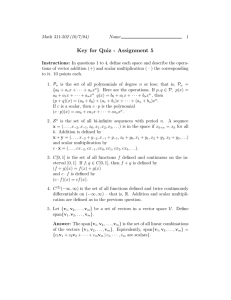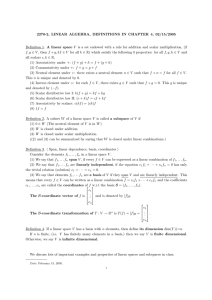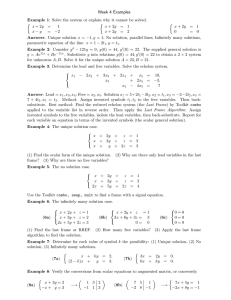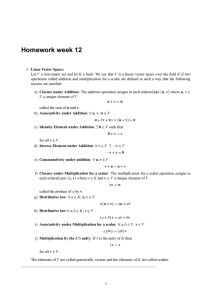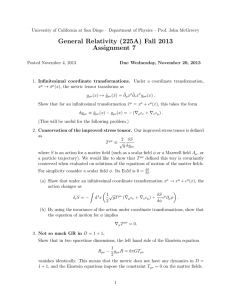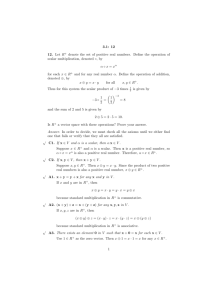Document 11364956
advertisement
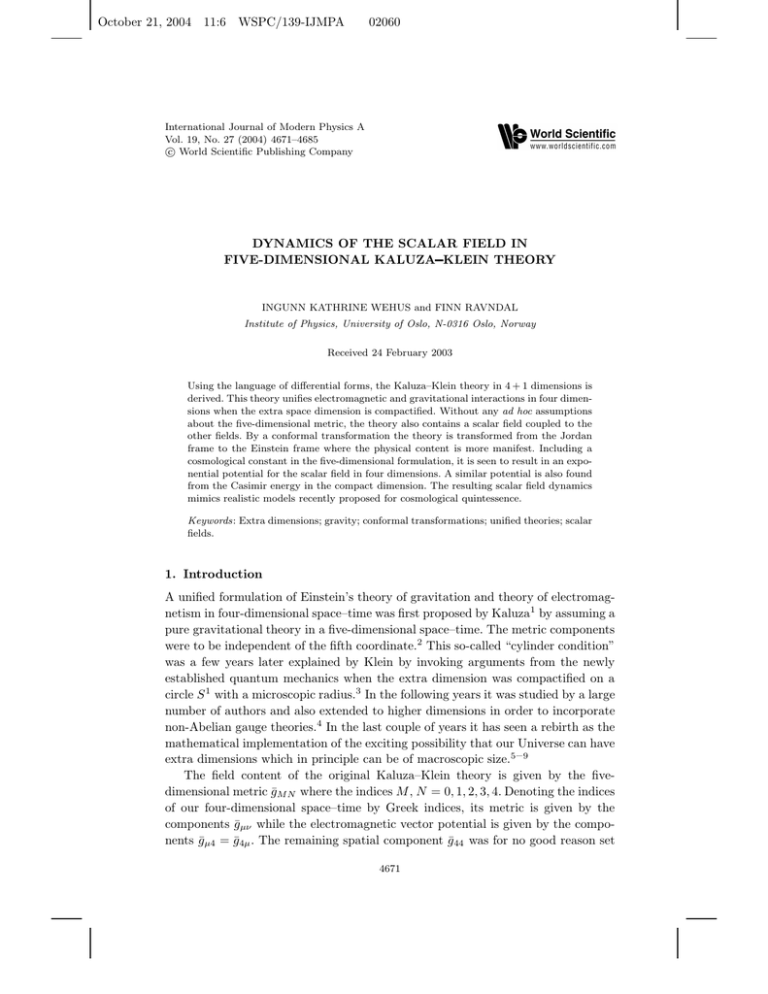
October 21, 2004 11:6 WSPC/139-IJMPA 02060 International Journal of Modern Physics A Vol. 19, No. 27 (2004) 4671–4685 c World Scientific Publishing Company DYNAMICS OF THE SCALAR FIELD IN FIVE-DIMENSIONAL KALUZA KLEIN THEORY INGUNN KATHRINE WEHUS and FINN RAVNDAL Institute of Physics, University of Oslo, N-0316 Oslo, Norway Received 24 February 2003 Using the language of differential forms, the Kaluza–Klein theory in 4 + 1 dimensions is derived. This theory unifies electromagnetic and gravitational interactions in four dimensions when the extra space dimension is compactified. Without any ad hoc assumptions about the five-dimensional metric, the theory also contains a scalar field coupled to the other fields. By a conformal transformation the theory is transformed from the Jordan frame to the Einstein frame where the physical content is more manifest. Including a cosmological constant in the five-dimensional formulation, it is seen to result in an exponential potential for the scalar field in four dimensions. A similar potential is also found from the Casimir energy in the compact dimension. The resulting scalar field dynamics mimics realistic models recently proposed for cosmological quintessence. Keywords: Extra dimensions; gravity; conformal transformations; unified theories; scalar fields. 1. Introduction A unified formulation of Einstein’s theory of gravitation and theory of electromagnetism in four-dimensional space–time was first proposed by Kaluza1 by assuming a pure gravitational theory in a five-dimensional space–time. The metric components were to be independent of the fifth coordinate.2 This so-called “cylinder condition” was a few years later explained by Klein by invoking arguments from the newly established quantum mechanics when the extra dimension was compactified on a circle S 1 with a microscopic radius.3 In the following years it was studied by a large number of authors and also extended to higher dimensions in order to incorporate non-Abelian gauge theories.4 In the last couple of years it has seen a rebirth as the mathematical implementation of the exciting possibility that our Universe can have extra dimensions which in principle can be of macroscopic size.5 – 9 The field content of the original Kaluza–Klein theory is given by the fivedimensional metric ḡM N where the indices M , N = 0, 1, 2, 3, 4. Denoting the indices of our four-dimensional space–time by Greek indices, its metric is given by the components ḡµν while the electromagnetic vector potential is given by the components ḡµ4 = ḡ4µ . The remaining spatial component ḡ44 was for no good reason set 4671 October 21, 2004 11:6 WSPC/139-IJMPA 4672 02060 I. K. Wehus & F. Ravndal equal to a constant by Kaluza1 and kept that way by the subsequent authors. This assumption was apparently first abandoned by Jordan10 and then later by Thiry11 who showed that ḡ44 corresponds to a scalar field in our space–time. At that time there was no need or place for such a field, but today we realize that it is a generic feature of almost any extension of Einstein’s theory of gravity. From the experimental point of view it can be related to the physics behind the dark energy12 in the Universe in the form of a cosmological constant13 or variable quintessence.14 The main motivation behind the present contribution is to investigate some of the physical properties and manifestations of such a scalar field. In order to make the presentation more accessible, we present the reduction of the five-dimensional theory down to our four-dimensional space–time in more detail than is generally available in the literature. We will take advantage of the simplifications which follow from using differential forms as was first done by Thiry.11 After this reduction, we find that the scalar field couples directly to the gravitational field. To get this part on the standard form, we perform a conformal transformation so that the gravitational part is described by the usual Einstein–Hilbert action. In this frame the scalar field couples only to the Maxwell field. It is shown that this form of the full action can be obtained by performing a conformal transformation on the five-dimensional metric. The classical equations of motion for the different fields are then derived and discussed. If there is a cosmological constant in the five-dimensional space–time, we show that it gives rise to an exponential potential for the scalar field. Such potentials are phenomenologically very interesting in cosmology where they can drive the observed acceleration of the Universe.14 A potential of the same form also follows from the Casimir energy in the compactified, extra dimension. Including both of these effects, we have an effective potential which is the sum of two exponential terms. Adjusting the parameters in this potential, one can then obtain a realistic cosmology of an accelerating Universe.15,16 2. Reduction to Four Dimensions In the five-dimensional space–timea we have the line element ds̄2 = ḡM N dxM dxN where the coordinates are xM = (xµ , x4 ≡ y). It is convenient to define ḡ44 = h and ḡ4µ = hAµ where the fields h(x) and Aµ (x) at this stage depend on all five coordinates. Our four-dimensional space–time is orthogonal to the basis vector ~e 4 in the extra direction. It is therefore spanned by the four basis vectors ~e µ⊥ = ~eµ − ~eµk = ~eµ − and is endowed with the metric gµν = ~eµ⊥ · ~eν⊥ = ḡµν − a The ḡµ4 ~eµ · ~e4 ~e4 = ~eµ − ~e 4 ~e4 · ~e4 ḡ44 (1) ḡ4µ ḡ4ν = ḡµν − hAµ Aν . ḡ44 (2) flat metric in this space–time has the diagonal components ηM N = (−1, 1, 1, 1, 1). October 21, 2004 11:6 WSPC/139-IJMPA 02060 Dynamics of the Scalar Field in Five-Dimensional Kaluza–Klein Theory 4673 In this way we then have the following splitting of the five-dimensional metric " # gµν + hAµ Aν hAµ ḡM N = (3) hAν h and correspondingly for the contravariant components # " µν −Aµ g MN ḡ = −Aν h−1 + Aµ Aµ (4) which satisfy ḡM N ḡ N P = δM P . The line element in this space–time thus takes the form ds̄2 = ḡµν dxµ dxν + 2ḡµ4 dxµ dx4 + ḡ44 dx4 dx4 = gµν dxµ dxν + h(dy + Aµ dxµ )2 . (5) The appearance of the gauge potential 1-form in the last term is characteristic for Kaluza–Klein theories also with additional extra dimensions.4 At this stage we impose the cylinder condition ḡM N,4 = 0 which means that the fields gµν (x), Aµ (x) and h(x) are independent of the fifth coordinate y. 2.1. Vierbeins and connection forms In the four-dimensional space–time we introduce the vierbeins V µ̂ν and their inverse V µν̂ satisfying V µ̂λ V λν̂ = δ µ̂ν̂ and V µν̂ V ν̂λ = δ µλ . The metric is thus gµν = V α̂µ V β̂ν ηα̂β̂ where ηα̂β̂ is the four-dimensional Minkowski metric in this space–time. Using these vierbeins we find the orthonormal basis 1-forms as ω µ̂ = V µ̂ν dxν . (6) In the fifth direction we see from the line element (5) that the basis 1-form is √ ω 4̂ = h(dy + Aµ dxµ ) . (7) Now using standard methods,17 we can calculate the connection 1-forms and the curvature 2-forms needed to find the Riemann and Ricci tensors which enter the Einstein–Hilbert action. As an example, we find dω 4̂ = 1 −1/2 h h,µ dxµ ∧ (dy + Aµ dxµ ) + h1/2 Aµ,ρ dxρ ∧ dxµ 2 4̂ 4̂ since d2 y = 0. The result can be written in the form dω 4̂ = −Ω̄ µ̂ ∧ ω µ̂ where Ω̄ µ̂ is the corresponding five-dimensional connection 1-form. By using the antisymmetry of dxρ ∧ dxµ to introduce the field strength Fµν = Aν,µ − Aµ,ν , we find 1 1√ 4̂ h,µ̂ ω 4̂ , (8) hFµ̂ν̂ ω ν̂ + Ω̄ µ̂ = 2 2h where h,µ̂ = h,ν V νµ̂ . Using the antisymmetry in the two orthonormal indices, we µ̂ then also have the value for Ω̄ 4̂ which we will need in the following. October 21, 2004 11:6 WSPC/139-IJMPA 4674 02060 I. K. Wehus & F. Ravndal The exterior derivative of the remaining basis forms is similarly given in five dimensions as µ̂ µ̂ dω µ̂ = −Ω̄ ν̂ ∧ ων̂ − Ω̄ ∧ ω 4̂ 4̂ while taken in the four-dimensional space–time it would just be dω µ̂ = −Ωµ̂ ν̂ ∧ ω ν̂ where Ωµ̂ ν̂ now is the the connection 1-form in four dimensions. We thus have the relationship 1√ µ̂ hFν̂ µ̂ ω4̂ (9) Ω̄ ν̂ = Ωµ̂ ν̂ + 2 between the connections in these two space–times. 2.2. Curvature forms and tensors The curvature 2-forms are defined by the structure equation 1 µ̂ R ω ρ̂ ∧ ωσ̂ (10) 2 ν̂ ρ̂σ̂ in the four-dimensional space–time and correspondingly in five dimensions. Their components Rµ̂ ν̂ ρ̂σ̂ form the Riemann curvature tensor in the orthonormal frame we are working in. In the same frame the corresponding expansion of the connection forms is Rµ̂ ν̂ = dΩµ̂ ν̂ + Ωµ̂ λ̂ ∧ Ωλ̂ ν̂ ≡ Ωµ̂ ν̂ = Ωµ̂ ν̂σ dxσ , (11) where Ωµ̂ ν̂σ are the connection coefficients. These will enter the calculation together with partial derivatives of the field strengths F µ̂ν̂ to give the covariant derivative F µ̂ν̂;σ = F µ̂ν̂,σ + Ωµ̂ ρ̂σ F ρ̂ν̂ − Ωρ̂ ν̂σ F µ̂ρ̂ (12) and similarly for the other components. We calculate first the curvature form R̄µ̂ 4̂ from µ̂ R̄µ̂ 4̂ = dΩ̄ µ̂ 4̂ + Ω̄ ν̂ ν̂ ∧ Ω̄ 4̂ . Along the direction ω ρ̂ ∧ ω σ̂ we then find the curvature tensor components 1√ 1 R̄µ̂ 4̂ρ̂σ̂ = hFσ̂ ρ̂ ;µ̂ + √ 2h;µ̂ Fσ̂ ρ̂ + h;ρ̂ Fσ̂ µ̂ − h;σ̂ Fρ̂ µ̂ 2 4 h (13) (14) and similarly R̄µ̂ 4̂ρ̂4̂ = 1 µ̂ν̂ 1 ;µ̂ 1 F Fρ̂ν̂ − h ;ρ̂ + 2 h;µ̂ h;ρ̂ 4 2h 4h (15) in the direction of ω ρ̂ ∧ ω 4̂ . These are all the components of the Riemann tensor involving the fifth index, since the Riemann tensor is antisymmetric in the first two and in the last two indices. We have here introduced the notation Fσ̂ρ̂;µ̂ = Fσ̂ ρ̂;ν V νµ̂ for the covariant derivative of the field tensor. We have also simplified the result using the Bianchi identity Fσ̂ ρ̂;µ̂ + Fρ̂µ̂;σ̂ + Fµ̂σ̂;ρ̂ = 0. October 21, 2004 11:6 WSPC/139-IJMPA 02060 Dynamics of the Scalar Field in Five-Dimensional Kaluza–Klein Theory 4675 The remaining components of the curvature tensor follow now from the 2-form µ̂ R̄µ̂ ν̂ = dΩ̄ µ̂ ν̂ + Ω̄ λ̂ ∧ Ω̄ λ̂ µ̂ ν̂ + Ω̄ 4̂ ∧ Ω̄ 4̂ ν̂ (16) which can be evaluated along the same lines. It gives 1 R̄µ̂ ν̂ ρ̂σ̂ = Rµ̂ ν̂ ρ̂σ̂ + h 2Fν̂ µ̂ Fρ̂σ̂ − Fρ̂ µ̂ Fσ̂ ν̂ − Fσ̂ µ̂ Fν̂ ρ̂ (17) 4 which has the correct antisymmetry in the first and last two indices. We also notice that the symmetry R̄µ̂ν̂ ρ̂σ̂ = R̄ρ̂σ̂ µ̂ν̂ is satisfied, as well as R̄µ̂ [ν̂ ρ̂σ̂] = 0. The Ricci curvature tensor is defined in four dimensions to be Rν̂ σ̂ = Rµ̂ ν̂ µ̂σ̂ and similarly in five dimensions. It is symmetric in its two indices. We find its components to be 1 1 ;µ̂ 1 ;µ̂ R̄4̂4̂ = hF µ̂ν̂ Fµ̂ν̂ − h + h h;µ̂ , (18) 4 2h ;µ̂ 4h2 1√ 3 R̄ν̂ 4̂ = (19) hFν̂ µ̂ ;µ̂ + √ Fν̂ µ̂ h;µ̂ , 2 4 h 1 1 1 R̄ν̂ σ̂ = Rν̂ σ̂ − hF µ̂ν̂ Fµ̂σ̂ − h;ν̂ σ̂ + 2 h;ν̂ h;σ̂ . (20) 2 2h 4h For the scalar curvature R̄ = R̄µ̂ µ̂ expressed in a coordinate basis we then have 1 1 1 (21) R̄ = R − hF µν Fµν − ∇2 h + 2 (∇µ h)2 4 h 2h in agreement with Thiry.11 Here we have introduced the ∇-operator for the covariant derivative and ∇2 = ∇µ ∇µ is the four-dimensional d’Alembertian operator. Needless to say, it is the appearance of the Maxwell Lagrangian in this higherdimensional curvature first derived by Kaluza and Klein, that we still do not understand the full significance of. 2.3. Einstein Hilbert action and equations of motion These geometrical considerations become physical when we postulate that gravitation in the five-dimensional space is governed by the corresponding Einstein–Hilbert action Z √ 1 3 S = M̄ (22) d5 x −ḡR̄ , 2 where M̄ is the Planck mass in this space and R̄ is the Ricci curvature scalar (21). In principle there can also be an additional term here corresponding to a cosmological constant. Its implications will be considered in Subsec. 4.1. From the 4 + 1 split of the metric in (3) we see that its determinant is simply ḡ = hg where g is the determinant of the four-dimensional metric gµν . Using this in the action (22) and then integrating out the fifth coordinate, we find the action Z √ √ 1 1 1 1 (23) S = M 2 d4 x −g h R − hF µν Fµν − ∇2 h + 2 (∇µ h)2 , 2 4 h 2h October 21, 2004 11:6 WSPC/139-IJMPA 4676 02060 I. K. Wehus & F. Ravndal when the extra dimension is a microscopic circle of radius a so that M 2 = 2πaM̄ 3 becomes the ordinary, four-dimensional Planck constant. The two last terms form a total derivative, √ 1 2 √ 1 h ∇ h − 2 (∇µ h)2 = 2∇2 h . (24) h 2h Assuming that h disappears far away these terms can be neglected from the action. We are therefore left with the final result Z √ 1 2 1 µν 4 √ S= M d x −g h R − hF Fµν (25) 2 4 which is the Kaluza–Klein action. In the general case where the scalar field h(x) varies with position, the effective gravitational constant given by the coefficient of the Ricci scalar in (25), is no longer a constant, but varies with time and position in the four-dimensional space–time. Electromagnetic interactions described by the Maxwell part, will similarly have a variable coupling strength. For this reason the theory seems to be in disagreement with present-day observations although there have been recent indications that the fine-structure constant may vary over cosmological time scales. 18 Kaluza– Klein theory thus belongs to a wider class of fundamental theories characterized by the extension of Einstein’s tensor theory of gravity to include also the effect of scalar interactions. Such scalar-tensor theories of gravitation were constructed by Jordan19 and later shown by Brans and Dicke20 to be compatible with gravitational experiments and cosmological tests. The classical equations of motion for the three fields can be derived from the action (25). But it is simpler to use the five-dimensional action (22) which gives rise to the equation of motion R̄M N = 0. We have already the components of the Ricci tensor in orthonormal basis (18)– (20). We now transform these to coordinate basis using the√ vierbeins V µ̂ν , along √ with the rest of the fünfbein components V µ̂4 = 0, V 4̂µ = hAµ and V 4̂4 = h, which we read out from (6) and (7). We then find 1 1 1 (∇µ h)2 , (26) R̄44 = h2 F µν Fµν − ∇2 h + 4 2 4h 3 1 R̄µ4 = h∇ν Fµν + Fµν ∇ν h 2 4 1 1 1 + Aµ h2 F µν Fµν − ∇2 h + (27) (∇µ h)2 , 4 2 4h 1 1 1 hF σµ Fσν − ∇µ ∇ν h + 2 (∇µ h)(∇ν h) 2 2h 4h 1 2 1 1 2 µν 2 + Aµ Aν h F Fµν − ∇ h + (∇µ h) 4 2 4h 3 3 1 1 + Aν h∇σ Fµσ + Fµσ ∇σ h + Aµ h∇σ Fνσ + Fνσ ∇σ h . (28) 2 4 2 4 R̄µν = Rµν − October 21, 2004 11:6 WSPC/139-IJMPA 02060 Dynamics of the Scalar Field in Five-Dimensional Kaluza–Klein Theory 4677 By equating these components of the Ricci scalar to zero we find the corresponding four-dimensional equations of motion. With the help of the identity (24), we find from (26) for the scalar field √ 1 ∇2 h = h3/2 F µν Fµν 4 (29) while (27) combined with (29) gives the equation of motion for the Maxwell field, ∇µ Fµν = − 3 Fµν ∇µ h . 2h (30) Finally, for the gravitational field we find from (28) when using (29) and (30) Rµν = √ 1 1 σ hF µ Fσν + √ ∇µ ∇ν h . 2 h (31) These equations can also be found in Wesson.21 Introducing the Einstein curvature tensor Eµν = Rµν − 21 Rgµν , we see that the last equation can be written as √ √ 1 1 1 Eµν = h F σµ Fσν − gµν F ρσ Fρσ + √ ∇µ ∇ν h − gµν ∇2 h (32) 2 4 h when we express the Ricci scalar R in terms of the Maxwell and scalar fields using (21) with R̄ = 0. In the first term we recognize the energy–momentum tensor of the electromagnetic field, while the last term must be the corresponding entity for the scalar field in this representation. From the equation of motion (29) for the scalar field we see that it can take a constant value, which can be chosen to be h = 1, provided the accompanying gauge field satisfies the special condition F µν Fµν = 0. The magnitudes of the electric and magnetic fields must therefore be the same everywhere. This rather strong and unnatural condition was imposed for many years in investigations of the Kaluza– Klein theory4 since there did not seem to be a real physical need for a scalar field on the same footing as the electromagnetic and gravitational fields. Today, however, the situation is different. In fact, scalar fields are at the core of the Higgs mechanism in particle physics, cosmological inflation in the early universe and dark energy in the late universe. In the following we will therefore keep the scalar field nonconstant and study some of its physical implications. 3. Conformal Transformations to the Einstein Frame A basic assumption in Einstein’s general theory of relativity is that all observers are equipped with standard measuring rods and clocks. The properties of these rods and clocks are coded into the components of the metric tensor gµν and has the consequence that the gravitational action is just given by the volume integral of the Ricci curvature scalar. This is obviously the case for the underlying, fivedimensional theory described by (22). But in the resulting,√four-dimensional theory (25) we see that this term is multiplied by the scalar field h which is generally not October 21, 2004 11:6 WSPC/139-IJMPA 4678 02060 I. K. Wehus & F. Ravndal constant. This corresponds to using nonstandard measuring rods and clocks. We can now adjust these by changing the metric at every point by a Weyl transformation gµν → Ω2 gµν (33) and choosing the scale factor Ω(x) appropriately. In a D-dimensional space–time this results in the corresponding change Rµν → Rµν − Ω−1 ∇2 Ωgµν − (D − 2)Ω−1 ∇µ ∇ν Ω − (D − 3)Ω−2 (∇ρ Ω)2 gµν + 2(D − 2)Ω−2 ∇µ Ω∇ν Ω (34) of the Ricci tensor. This gives a change in the Ricci scalar R → Ω−2 R − 2(D − 1)Ω−3 ∇2 Ω − (D − 1)(D − 4)Ω−4 (∇µ Ω)2 (35) as shown in Ref. 22. 3.1. Weyl transformations √ √ When we are in D = 4 dimensions −g → Ω4 −g while the Ricci scalar changes according to (35). The first term in (25) thus changes as Z Z √ √ √ √ d4 x −g hR → d4 x −gΩ4 h Ω−2 R + · · · . (36) For the coefficient of R to take the canonical value we must therefore choose Ω = h−1/4 . Including the Maxwell term in (25) and the second term of the Weyl transformation (35) we thus find the transformed Kaluza–Klein action Z 15 1 1 23 µν 31 2 1 2 2 4 √ ∇ h− (∇µ h) . (37) d x −g R − h F Fµν + S= M 2 4 2h 8 h2 It can be simplified by combining the last two terms by a partial integration which results in Z 1 2 1 3 µν 3 1 2 4 √ 2 (∇µ h) . S= M (38) d x −g R − h F Fµν − 2 4 8 h2 After this Weyl transformation we are now in the Einstein frame. By construction the gravitational part in the first term of the action has now the canonical form. The last term describes a massless scalar field which is coupled to the electromagnetic field in the second term. This is the physical content of the Einstein frame theory. For similar transformations between the Jordan frame and the Einstein frame for dilatonic brane-worlds see Ref. 23. We could have achieved the same result by performing the Weyl transformation (33) directly on the five-dimensional metric appearing in (22). Since we now have √ √ −ḡ → Ω5 −ḡ, we find that the transformation needed is Ω = h−1/6 . Again using (35) where now also the last term contributes and the gradients act in five dimensions, we find Z Z √ √ 1 4 1 2 0 0 2 ∇ h − d5 x −ḡR̄ → d4 x −g R̄ + (∇ h ) . (39) µ 3 h0 h0 2 October 21, 2004 11:6 WSPC/139-IJMPA 02060 Dynamics of the Scalar Field in Five-Dimensional Kaluza–Klein Theory 4679 For later convenience we have here denoted the scalar field h0 instead of h. By using (21) for the five-dimensional scalar curvature, we find the transformed action integral Z √ 1 1 1 1 2 0 1 1 0 2 (∇ h ) . (40) S = M 2 d4 x −g R − h0 F µν Fµν + ∇ h − µ 2 4 3 h0 2 h0 2 Again we can use a partial integration to combine the two last terms, as in (38). The final result for the Kaluza–Klein action after a five-dimensional Weyl transformation is then Z √ 1 1 1 1 0 2 . (41) S = M 2 d4 x −g R − h0 F µν Fµν − (∇ h ) µ 2 4 6 h0 2 We see that there is full agreement between the four-dimensional Weyl transformation gµν → h−1/2 gµν and the five-dimensional counterpart ḡM N → h−1/3 ḡM N . If we put h0 = h3/2 in (41) this equation is transformed into (38). This is also easily understood directly from the five-dimensional metrical structure (3). After the four-dimensional Weyl transformation the five-dimensional metric becomes # " −1 3 3 gµν + h 2 Aµ Aν h 2 Aµ h 2 gµν + hAµ Aν hAµ 1 . = h− 2 3 3 2 2 hAν h h Aν h Introducing here h0 = h3/2 we then have the Weyl transformation of the fivedimensional metric used above. 3.2. Canonical fields Although the gravitational part of the action now has the standard form, the kinetic energies of scalar and electromagnetic fields do not have their canonical forms. However, this is simple to achieve. In the action (41) we introduce h0 = e √ 6φ/M , (42) where now φ(x) is a scalar field with canonical normalization. Similarly, we redefine the electromagnetic field by √ Aµ → 2Aµ /M (43) and the Kaluza–Klein action takes its final form Z 1 2 1 √6φ/M µν 1 2 4 √ S = d x −g M R − e F Fµν − (∇µ φ) . 2 4 2 (44) When the scalar field φ has values much less than the Planck mass M , both the electromagnetic field and the scalar field are seen to be free. October 21, 2004 11:6 WSPC/139-IJMPA 4680 02060 I. K. Wehus & F. Ravndal 3.3. Equations of motion in Einstein frame 1 Now that we have performed the Weyl transformation ḡM N → h− 3 ḡM N the equations of motion are no longer the same as Eqs. (29), (30) and (32) in the Jordan frame. We can find the new equations of motion from the transformed fourdimensional action (41). Varying this action with respect to h gives 1 3 2 h Fµν F µν + (∇µ h)2 . 4 h Similarly the equation for Aµ is found to be ∇2 h = 1 ∇ν Fµν = − Fµν ∇ν h h while varying with respect to gµν gives us 1 scalar 1 el.mag. hTµν + 2 Tµν . Eµν = 2 3h (45) (46) (47) el.mag. Here Tµν = F αµ Fαν − 41 F ρσ Fρσ gµν is the ordinary electromagnetic energy– scalar momentum tensor, while Tµν = ∇µ h∇ν h− 21 (∇σ h)2 gµν is the energy–momentum tensor for a free scalar field. By performing the canonical transformations (42) and (43) we then obtain the equations of motion in canonical normalization: r 3 √6φ/M 2 Fµν F µν , (48) e ∇ φ= 8M 2 √ 6 ν ∇ Fµν = − Fµν ∇ν φ , (49) M i 1 h √ el.mag. scalar + Tµν . (50) Eµν = 2 e 6φ/M Tµν M We can also get Eqs. (45)–(47) by varying the five-dimensional action after the 0 0 Weyl transformation. This gives R̄M N = 0, where R̄M N is the transformed Ricci 2 − 31 and we get the following tensor which we find from (34). In our case Ω = h expression for the transformed Ricci tensor: 5 ¯ 1 ¯ ¯N h (∇P h)2 ḡM N − ∇M h∇ 4h2 12h2 1 ¯2 1 ¯ ¯ ∇M ∇N h + ∇ hgM N . (51) + 2h 6h Here we have barred the covariant derivative to remind the reader that it is the covariant derivative with respect to the five-dimensional metric. The relationship ¯ 2 h = ∇2 h + between the d’Alembertian operator in four and five dimensions is ∇ 1 2 2h (∇µ h) . By computing a couple of Christoffel symbols we find 0 R̄M N = R̄M N − ¯4 ∇ ¯ 4 h = 1 (∇µ h)2 , ∇ 2 ¯4 ∇ ¯ν h = 1 (∇µ h)2 Aν − 1 h∇µ hF µ , ∇ ν 2 2 (52) (53) October 21, 2004 11:6 WSPC/139-IJMPA 02060 Dynamics of the Scalar Field in Five-Dimensional Kaluza–Klein Theory ¯µ ∇ ¯ν h = ∇µ ∇ν h + 1 (∇σh)2 Aµ Aν ∇ 2 1 − h∇ρ h(Aµ Fνρ + Aν Fµρ ) . 2 4681 (54) 0 When we now equate the various components of R̄M N to zero and use the expressions (26)–(28) for the untransformed Ricci tensor, we end up with Eqs. (45)–(47). To get the last equation we must also use the fact that the transformed Ricci scalar R̄0 = 0. 4. Potential Energy for the Scalar Field So far the scalar field is massless and will therefore modify the gravitational interactions over cosmological distances. This is surely unwanted and is easily avoided by slightly enlarging the theory. By including a cosmological constant in five dimensions we will see that the scalar field develops a potential and thus also a nonzero mass. Alternatively, we will see that the Casimir vacuum energy induced by the presence of the compact, fifth dimension also generates a similar potential. 4.1. Cosmological constant in five dimensions With a cosmological constant Λ̄ in the original, five-dimensional theory, the fundamental action (22) is replaced by Z √ 1 (55) S = M̄ 3 d5 x −ḡ(R̄ − 2Λ̄) . 2 Going through the same compactification as before, followed by the Weyl transformation in five dimensions, it immediately follows that Z 1 √ 1 1 1 1 0 2 0− 3 . (56) (∇ h ) − 2 Λ̄h S = M 2 d4 x −g R − h0 F µν Fµν − µ 2 4 6 h0 2 Introducing here the canonically normalized fields, it takes the more informative form: Z √ 1 √6φ/M µν 1 2 1 2 2 4 √ − 23 φ/M . (57) S = d x −g M R − e F Fµν − (∇µ φ) − M Λ̄e 2 4 2 The five-dimensional cosmological constant is thus seen to correspond to an exponential potential in four dimensions. Its absolute sign is directly set by the sign of Λ̄. Such an exponential potential for a scalar field addition to Einstein’s tensor theory was first considered by Wetterich.24 It has been much studied since then in connection with models for quintessence.14 Its cosmological evolution is completely characterized by the coefficient of φ in the exponent. October 21, 2004 11:6 WSPC/139-IJMPA 4682 02060 I. K. Wehus & F. Ravndal 4.2. Casimir energy from the compact dimension The cosmological constant is a contribution to the vacuum energy from physics on short scales, i.e. scales shorter than the size Z 2πa √ √ (58) L= dy h = 2πae 2/3φ/M 0 of the compact dimension. But including quantum effects, the Casimir energy will contribute to the vacuum energy at the scale L due to the confinement of the massless field quanta in a space with a compact, fifth dimension. The corresponding momentum is therefore quantized with the values p = (2π/L)n where n = 0, ±1, ±2, . . . , ±∞. In (58) we have chosen to calculate L after the four-dimensional Weyl transformation, which means that √ the correspondence between φ(x) and h(x) is √ given by h = (e 6φ/M )2/3 = e2 2/3φ/M . The calculation of the Casimir energy is done in lowest order perturbation theory where the field quanta represent small oscillation around the ground state ḡM N = ηM N which follows from the classical equations of motion. Considering first the contribution from one such massless mode, it gives rise to the Casimir energy Z ∞ V d3 k X p 2 E0 = k + (2πn/L)2 , (59) 2 (2π)3 n=−∞ where V is a finite 3-volume. Using dimensional regularization, we do the momentum integral in d dimensions where we have the general formula Z dd k 1 Γ(N − d/2) 2 d/2−N = (4π)−d/2 (m ) . (60) (2π)3 (k 2 + m2 )N Γ(N ) In our case N = −1/2 and we find d+1 ∞ d+1 V X 2πn −d/2 Γ − 2 E0 = . (4π) 2 n=−∞ L Γ − 12 The sum over the compact quantum number n is still divergent. It is made finite with zeta-function regularization which gives ∞ X n=−∞ nd+1 = 2ζ(−d − 1) . Taking now d → 3, we have (61) V 2 π Γ(−2)ζ(−4) . (62) L4 Although Γ(−2) is infinite and ζ(−4) is zero, their product is finite as follows from the reflection formula z −z/2 1 − z −(1−z)/2 Γ π ζ(z) = Γ π ζ(1 − z) (63) 2 2 E0 = − October 21, 2004 11:6 WSPC/139-IJMPA 02060 Dynamics of the Scalar Field in Five-Dimensional Kaluza–Klein Theory 4683 for zeta-functions. We put z = −4 in this formula and use it to rewrite E0 . The corresponding vacuum energy density E0 = E0 /V L in five dimensions is then E0 = − 3ζ(5) . 4π 2 L5 (64) This is in agreement with the result of Applequist and Chodos25 obtained by a more indirect approach. It also follows from the calculations of Ambjørn and Wolfram26 who studied Casimir energies in different geometries. More recently the corresponding Casimir energy has been calculated by Albrecht, Burgess, Ravndal and Skordis 27 in a similar Kaluza–Klein theory in six dimensions of which two are compact in order to derive a corresponding scalar potential. Elizalde et al. have calculated the corresponding Casimir energy for an anti-de Sitter background.28 In five dimensions the graviton has five physical degrees of freedom. The total Casimir energy is thus the above calculated result (64) times five. With the length L expressed by the scalar field as in (58), we put this energy into the five-dimensional action integral and obtain the potential √ 1 4 15ζ(5) −6√ 2 φ/M 3 (65) e V (φ) = 5E0 (2πa) h h− 4 = − (2π)6 a4 in the Einstein frame. This potential term enters the Kaluza–Klein action instead of the last term in (57). It has the same exponential form as the contribution from the cosmological constant, but the exponent is six times as large. In general the potential will get contributions both from the small-scale cosmological constant and from the Casimir energy. It will thus have the form V (φ) = Ae−αφ + Be−βφ , (66) where the exponents are fixed but the coefficients are unknown. We only know that at least one of the prefactors A or B must be negative in this particular theory. Including also higher order quantum corrections to the Casimir energy, the simple exponential result will be modified. In the six-dimensional theory of Albrecht, Burgess, Ravndal and Skordis27 the radiative corrections add up to a polynomial in the field φ. This modification can be important when such potentials are used in models for cosmological quintessence.29 5. Conclusions The original, five-dimensional theory of Kaluza and Klein is the simplest example of the more elaborate theories used today to describe physics with extra dimensions. In addition to unifying the electromagnetic and gravitational fields, it also contains a scalar field which codes the size of the single extra dimension here. Similar theories with additional compact dimensions will contain a corresponding scalar field which is usually called the radion.6 This represents an extension of Einstein’s tensor theory of gravity and can have important, cosmological consequences. In this connection the radion field appears as quintessence which can give rise to acceleration of the October 21, 2004 11:6 WSPC/139-IJMPA 4684 02060 I. K. Wehus & F. Ravndal Universe at late times. This depends on the field dynamics which is governed by its effective potential which appears in the Einstein frame. Here it is pointed out that this effective potential will in the lowest order approximation used here be a sum of two exponential terms. One is resulting from the small-scale cosmological constant in the higher-dimensional space–time while the other is induced as a Casimir energy due to one or more compact dimensions. It has been shown by others that potentials of such a form allow for a consistent description of the evolution of the Universe since radiation domination until today when the dark energy dominates and gives acceleration.15,16 It would be even more satisfactory if also the inflationary mechanism could be explained by similar physics from extra dimensions. References 1. T. Kaluza, Sitzungsber. Preuss. Akad. Wiss. Phys. Mat. Klasse, 966 (1921). 2. G. Nordström, Phys. Zeit. 15, 504 (1914), had earlier used the same idea to formulate an in four dimensions unified theory of electromagnetism and his scalar theory of gravitation, based on Maxwell’s theory in a five-dimensional space–time. 3. O. Klein, Zeit. F. Phys. 37, 895 (1926); Nature 118, 516 (1926). 4. T. Appelquist, A. Chodos and P. G. O. Freund, Modern Kaluza–Klein Theories (Addison-Wesley, Menlo Park, California, 1987). 5. I. Antoniadis, Phys. Lett. B246, 377 (1990). 6. N. Arkani-Hamed, S. Dimopoulos and G. Dvali, Phys. Lett. B429, 263 (1998); Phys. Rev. D59, 086004 (1999). 7. I. Antoniadis, N. Arkani-Hamed, S. Dimopoulos and G. Dvali, Phys. Lett. B436, 257 (1998). 8. T. Han, J. D. Lykken and R. Zhang, Phys. Rev. D59, 105006 (1999). 9. G. F. Giudice, R. Rattazzi and J. D. Wells, Nucl. Phys. B544, 3 (1999). 10. P. Jordan, Ann. D. Physik 1, 219 (1947). 11. Y. Thiry, Comptes Rendus 226, 216 (1948). 12. P. J. E. Peebles and B. Ratra, astro-ph/0207347. 13. S. Weinberg, astro-ph/0005265. 14. For a recent summary, see M. Doran and C. Wetterich, astro-ph/0205267. 15. T. Barreiro, E. J. Copeland and N. J. Nunes, Phys. Rev. D61, 127301 (1999). 16. A. S. Majumdar, Phys. Rev. D64, 083503 (2001). 17. C. W. Misner, K. S. Thorne and J. A. Wheeler, Gravitation (W. H. Freeman and Company, New York, 1973). 18. J. K. Webb et al., Phys. Rev. Lett. 87, 091301 (2001). 19. P. Jordan, Nature 164, 637 (1949); Schwerkraft und Weltall (Friedr. Vieweg & Sohn, Braunschweig, 1952). 20. C. Brans and R. H. Dicke, Phys. Rev. 124, 925 (1961). 21. P. S. Wesson, Space, Time, Matter : Modern Kaluza–Klein Theory (World Scientific, Singapore, 1999). 22. S. W. Hawking and G. F. R. Ellis, The Large Scale Structure of Space–Time (Cambridge University Press, Cambridge, 1973). 23. S. Nojiri, O. Obregon, S. D. Odintsov and V. I. Tkach, Phys. Rev. D64, 043505 (2001). 24. C. Wetterich, Nucl. Phys. B302, 668 (1988). 25. T. Appelquist and A. Chodos, Phys. Rev. D28, 772 (1983). October 21, 2004 11:6 WSPC/139-IJMPA 02060 Dynamics of the Scalar Field in Five-Dimensional Kaluza–Klein Theory 4685 26. J. Ambjørn and S. Wolfram, Ann. Phys. (N.Y.) 147, 33 (1983). 27. A. Albrecht, C. P. Burgess, F. Ravndal and C. Skordis, Phys. Rev. D65, 123506, 123507 (2002). 28. E. Elizalde, S. Nojiri, S. D. Odintsov and S. Ogushi, hep-th/0209242. 29. A. Albrecht and C. Skordis, Phys. Rev. Lett. 84, 2076 (2000).
